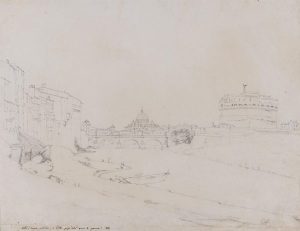Biography

CAFFI Ippolito, painter (Belluno 1809 – Lissa 1866). He formed in Belluno with Federici and Tessari, finishing his studies at the Academy of Fine Arts in Venice between 1827 and 1831 (in the 1930s he also won the Perspective Award).
In 1831 he settled in Rome with his cousin Paoletti, a history painter, who, well evaluating his tendencies, pushed him to abandon figure painting to address the view and the landscape. His first known works of this Roman stay still show a close adherence to the eighteenth-century perspective of Canaletto, updated by direct comparison with motifs taken from life.
He immediately committed himself to the search for “special effects”, such as nocturnal, popular festival scenes, particular atmospheric effects through which he intends to redeem his Roman views from the banal and stereotyped compared to the thousand versions provided by painters from all over Europe. Caffi will insist on this throughout his artistic career, supported by an innate curiosity and by the overwhelming need to experiment. The public rewards his attempts: the 1837 painting of the Rome Carnival or Festival of the clogs will be replicated 42 times. Having established his home in Rome, the painter actually moved from one city to another, called by works commissions (in ’41 in Padua he painted four beautiful Roman views for Caffè Pedrocchi) or by participating in exhibitions. However, the wealth of stimuli that this frenetic activity entails does not seem to have led to particular changes in his way of painting.
Rather, the journey to the East (from the autumn of ’43 to the spring of ’44), with the suggestion of the exotic charm of the places represented, directs him to the use of warmer and brighter colors, freeing him from the slavery of rigid perspective. On his return to Venice, where he was offered the chair of painting at the Academy, he felt again the eighteenth-century landscape setting.
In 48 the well-known Risorgimento events involved him in full. After leaving Rome and enlisting against Austria, he is taken prisoner and shelters in Venice until the fall of the Republic. Proscribed by the Austrian government, he is forced to wander in various cities of Italy (Genoa in ’49, Turin in ’50) and also abroad (in ’51 we find him in London, where he participates in the Universal Exposition, in ’54 he is in Paris, also present here with three works at the Exhibition).
From 1855 to 1857 he stayed in Rome, obtaining the pictorial results of the happiest of all his production (see the two visions of Tivoli of the Museum of Rome or the Colosseum illuminated by the Bengal fires at Ca ‘Pesaro, Venice): they are more visions open, less rigidly constructed, firmly identified by the action of light. This period of calm and serenity was interrupted in 1958 by the trial celebrated in Venice for an alleged crime during the 1949 riot. Exonerated, he remains to live in Venice, but his intense patriotic activity is interrupted by his arrest (1860) and his imprisonment for three months.
Caffi died in Lissa in 1866 in the sinking of the Italian ship on which he had embarked to closely portray the episodes of the third war of Independence.